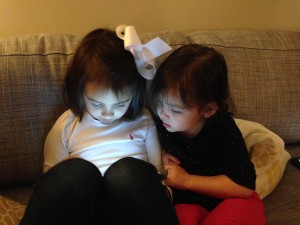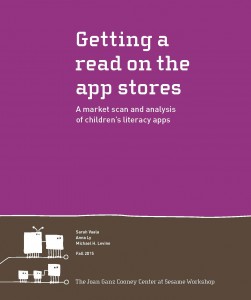Earlier this month the Joan Ganz Cooney Center released the latest in a line of tracking studies of the educational apps marketplace in collaboration with our colleagues at New America. What we found was—to be blunt—worrisome. Progress in the development of scientifically-informed early learning apps that parents and educators can easily find is far too slow. In the 5 years we have been digging into the apps marketplace (aka. “The digital Wild West”, we have frankly seen only scant progress in a development process that needs to be much more transparent, outcomes driven, and tuned into the needs of today’s more modern, more diverse families. Previously our blog has featured the perspectives of the co-authors of Getting a Read on the App Store, Sarah Vaala, who shared her perspectives as a literacy researcher and new mom, and Anna Ly, who wrote about the findings from her industry and media design perch at Sesame Workshop.
Today’s entry contemplates how, in this holiday season, a parent or educator might use our work to their benefit. What are the key take-always that a discerning adult might use, for example in deciding which app to purchase with a young child’s future literacy skills development on their minds? As always we value your feedback on our work and wish you a happy and healthy New Year! —Michael H. Levine

It’s the holiday season, and families everywhere are playing on digital devices at home and on the road. If you’ve got kids, and a smartphone or tablet, you have probably found yourself poking around the app stores in search of a great new game that will not only entertain your child, but hopefully help them learn something too. Developers know this—the educational apps category of Apple’s App Store alone has at least 80,000 titles. Our research suggests that most parents and educators find it daunting to swipe through screen after screen of “educational” apps without knowing what kinds of standards there might be. How’s a parent supposed to find what’s best for their child? And how does someone who develops really great apps get their products into the hands of the families who would most enjoy them?
As we head into the new year, we wanted to take a minute to reflect on the findings of Getting a Read on the App Stores, our most recent survey of the apps stories and what they mean for parents who are looking to facilitate the literacy development of their young children—and the developers who are creating apps for these users.
 When we embarked on this study in 2014, our teams at the Cooney Center and New America, led by Sarah Vaala and Anna Ly, decided to put ourselves into the shoes of parents looking for great apps for their kids. If we were looking for some high-quality educational apps for young children (which we defined as from birth to age 8) to teach them literacy skills, what would we find?
When we embarked on this study in 2014, our teams at the Cooney Center and New America, led by Sarah Vaala and Anna Ly, decided to put ourselves into the shoes of parents looking for great apps for their kids. If we were looking for some high-quality educational apps for young children (which we defined as from birth to age 8) to teach them literacy skills, what would we find?
Parents are finding most of the apps that they download from browsing the app stores. With that in mind, we wanted to learn more about what they were likely to encounter while browsing the most popular paid and free apps in the Apple App Store, Google Play, and Amazon Appstore. Among the literacy apps for children, what kinds of apps were among the most popular? How much information would a parent find while browsing the app stores to help them make decisions? And once an app had been downloaded, what would our families find? We also scanned the award-winning or highly-reviewed apps lists at three of the expert review sites, Common Sense Media, the Children’s Technology Review and Parents’ Choice to see what kind of overlap there might be in these lists—did experts agree that the most popular apps in the marketplace were the best?
After digging into the data for months, we realized there are key factors which can help a parent make informed decisions. And prepared with the right kind of knowledge, developers can help parents find their apps too. Here are some highlights of what we found that we think might be of interest.
-
Parents are likely to find different apps depending on where they look The featured or most popular apps on an app store may be very different from those highlighted by review sites. We found that the most popular apps may not be as highly rated as other apps for any number of reasons—so we encourage parents to look beyond the lists of top apps in the storefronts. Explore expert review sites like Common Sense Media, and ask teachers and librarians for recommendations.
-
Parents are looking for age-appropriate apps for their children Approximately 40% of apps did not provide a specific age range or developmental stage in their descriptions. Of those that did, 90% of the literacy-focused apps in our sample were aimed at preschool-age children. This suggests that parents should cast a wider net when searching for apps for older children, tapping expert review sites or librarians and teachers for advice.
-
Most apps do not mention specific benchmarks of educational quality Was there a child development or literacy expert on the team that produced this app? Is there a guiding curriculum or educational theory? What kind of research has been conducted to support an app’s claims to teach specific skills or concepts? We found that these questions were largely unanswered in the descriptions of the apps that we analyzed. While this does not necessarily suggest that there was no research conducted by or on behalf of the developers whose apps we looked at, parents and educators would feel more confidence downloading apps for their children that provide evidence of efficacy.
-
Research suggests that children learn well through co-use Unfortunately, few apps are designed to enable more than one participant to engage with an app. Does an app encourage an older user to play along? Can users create content together? The benefits of “joint media engagement” are significant when generations “learn together.”
-
Share feedback Parents and educators have the power to influence design! They should be more active to voice questions and concerns with individual developers or about the app stores in general. Whether by leaving a review, contacting a developer, or leaving feedback for the app stores in general, we suggest that parents can help push the market for high quality apps.
The Cooney Center and New America are strong advocates for the development of industry-wide standards for the education category, and we want to make sure that parents are aware that there are review sites that can help them make decisions. But until that happens, parents and educators will continue to rely heavily on the descriptions that developers provide as they scan the Top Apps lists. Perhaps, armed with the knowledge that can be gleaned from our scan, developers can help parents discover the kinds of apps that they are looking for (or perhaps didn’t even know they were looking for) while improving their own chances of rising to the top of the class.